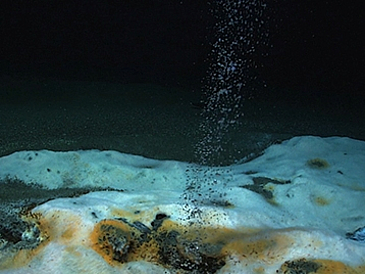In a study previewed online in the journal Nature Geoscience, Bremen marine researchers and their US colleagues have come up with an answer to a previously unsolved mystery on the ocean floor. The team has found evidence why methane in certain layers of the ocean bed exhibits an unusual isotope signature. The newly discovered biogeochemical process could also be of significance for other formation processes in the ocean.
While examining the isotope content of the methane found in marine sediments from around the world, Bremen researchers from MARUM and the Max Planck Institute for Marine Microbiology kept coming across a curious phenomenon: In places where microorganisms consume methane in the ocean bed with the help of sulfate, instead of finding the expected heavy carbon 13 in methane residues, they came across the lighter carbon 12. “Up to now, this finding was taken to be a clear indication for biological methane formation”, explains Marcos Yoshinaga, leading author of the Nature Geoscience study, who until recently was at MARUM and is now residing at the University of São Paulo. His colleague Marcus Elvert from MARUM joins in: “However, we couldn’t really imagine there could be a biogeochemical process capable of supporting active methane consumption”. The accepted wisdom was that methane consumption via oxidation mainly resulted in the formation of the lighter isotope carbon 12, and that the heavier carbon 13 subsequently becomes enriched in methane residues in the ocean bed.
The research team set up a laboratory experiment to test their findings in respect of the processes occurring on the ocean floor. “The Max Planck Institute‘s microbiological collection with its unique cultures of methane oxidizing microorganisms makes it possible to exactly reproduce such specific life conditions” says Max-Planck microbiologist Thomas Holler. And indeed: Where the microorganisms only found minimum amounts of sulfate available, the lab cultures retained amounts of methane that were enriched with the lighter isotope carbon 12.
Of course, the Bremen researchers now want to find out why in the case of low sulfate content the lighter carbon 12 becomes enriched in methane. They think a possible explanation may be that the biochemical reaction occurs very close to the energetic limit necessary to support life. Under such conditions all the substances involved in the reaction are almost in equilibrium. “As a result of this, the lighter carbon 12 finds itself in the methane”, explains Gunter Wegener from the Max Planck Institute. “We were able to underpin this finding with the aid of our biochemical models and hence provide an answer to a global phenomenon”, his colleague from MARUM, Tobias Goldhammer, confirms.
“Our study sheds new light on how certain archaea living in the ocean depths where energy is extremely scarce are able to adjust their metabolic processes to such conditions. It provides an answer to one of the central points of investigation of our project”, adds Kai-Uwe Hinrichs, who is also leader of the DARCLIFE project funded by the European Research Council. In a next step the researchers hope to find out whether other important biochemical processes on the ocean floor are also influenced by reactions in the same way as methane formation.
You can find more information under:
www.marum.de/Raetselhaftes_Methan.html
For further information / interview inquiries / photos, please contact:
Albert Gerdes
MARUM Communications
University of Bremen
Phone: +49 421 218 65540
e-mail: agerdesprotect me ?!marumprotect me ?!.de

